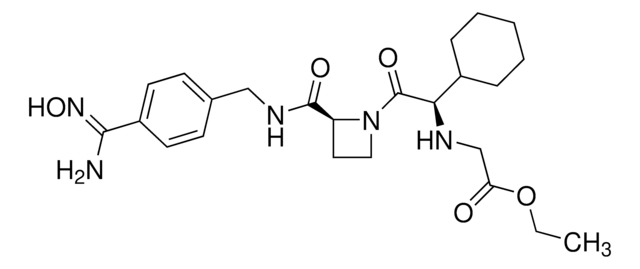Wichtige Dokumente
Z101
Zimelidin -dihydrochlorid
solid
Synonym(e):
(Z)-3-(4-Bromophenyl)-N,N-dimethyl-3-(3-pyridinyl)-2-propen-1-amine dihydrochloride
About This Item
Empfohlene Produkte
Form
solid
Qualitätsniveau
Farbe
white
Löslichkeit
0.1 M HCl: 45 mg/mL
H2O: 66 mg/mL
Ersteller
AstraZeneca
SMILES String
Cl[H].Cl[H].[H]\C(CN(C)C)=C(/c1ccc(Br)cc1)c2cccnc2
InChI
1S/C16H17BrN2.2ClH/c1-19(2)11-9-16(14-4-3-10-18-12-14)13-5-7-15(17)8-6-13;;/h3-10,12H,11H2,1-2H3;2*1H/b16-9-;;
InChIKey
CXGURXWCQYHDIR-ULPVBNQHSA-N
Angaben zum Gen
human ... HTR1A(3350) , HTR1B(3351) , HTR1D(3352) , HTR1E(3354) , HTR1F(3355) , HTR2A(3356) , HTR2B(3357) , HTR2C(3358) , HTR3A(3359) , HTR3B(9177) , HTR3C(170572) , HTR3D(200909) , HTR3E(285242) , HTR4(3360) , HTR5A(3361) , HTR5B(645694) , HTR6(3362) , HTR7(3363)
Anwendung
Biochem./physiol. Wirkung
Leistungsmerkmale und Vorteile
Rechtliche Hinweise
Signalwort
Warning
H-Sätze
Gefahreneinstufungen
Acute Tox. 4 Oral
Lagerklassenschlüssel
11 - Combustible Solids
WGK
WGK 3
Flammpunkt (°F)
Not applicable
Flammpunkt (°C)
Not applicable
Persönliche Schutzausrüstung
dust mask type N95 (US), Eyeshields, Gloves
Hier finden Sie alle aktuellen Versionen:
Besitzen Sie dieses Produkt bereits?
In der Dokumentenbibliothek finden Sie die Dokumentation zu den Produkten, die Sie kürzlich erworben haben.
Unser Team von Wissenschaftlern verfügt über Erfahrung in allen Forschungsbereichen einschließlich Life Science, Materialwissenschaften, chemischer Synthese, Chromatographie, Analytik und vielen mehr..
Setzen Sie sich mit dem technischen Dienst in Verbindung.








